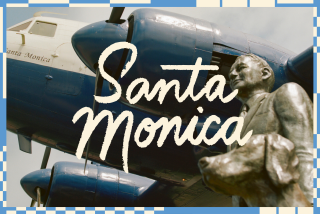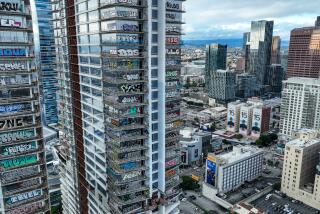Just Plane Folks : Santa Paula’s Hangars Hold Camaraderie, History
SANTA PAULA — Most airports tend to be less than friendly places. Looming and sterile, they thrive on anxious passengers fretting over ticket lines, traffic snarls, lost baggage and missed connections.
Not so at Santa Paula Airport, where the planes are private and small, and strangers are greeted with a smile.
Indeed, there are few unfamiliar faces at the 65-year-old Ventura County strip. The founder’s grandson serves on the board of directors, and many of the hangars are handed down from one generation to the next.
From the outside, most of these hangars look alike. Rows of bland corrugated aluminum, one hardly distinguishable from the next.
But behind the unwieldy metal doors, a quirky, attic-like quality prevails.
Perry Schreffler, 71, and Robert Van Ausdell, 74, discovered the tiny strip on a weekend pleasure flight from Los Angeles 35 years ago.
Planning to make some quick repairs and be on their way, they were charmed by the graciousness of Santa Paula’s pilots and, within a matter of days, bought adjoining hangars.
The pair were quickly dubbed Wilbur and Orville by the airport crowd.
“This is the friendliest airport in the world,” Van Ausdell said. “If we didn’t have this airport we’d all be (at the mental hospital) in Camarillo in a padded cell.”
Schreffler added: “This is the kind of place you fall in love with.”
On a recent morning, Schreffler showed up for his daily duties dressed in white mechanic’s coveralls and Air Force dog tags. He squeezed past a sagging sofa in the narrow lounge that links his hangar with Van Ausdell’s.
He bellied up to a well-worn, yellow upright piano and plunked out a few bars of “Stardust.”
“An old show tune,” he explained. “One of my favorites.”
As he pounded away, Van Ausdell rolled his eyes and backed out of the room.
Most days, Schreffler’s audience consists of two idle refrigerators, a wooden propeller and an unappreciative Van Ausdell.
But Van Ausdell’s seeming disrespect is merely a running joke in a decades-old friendship.
The two pilots were hired by TWA on the same day in 1944, became fast friends, worked side by side and retired exactly 33 years later.
Now they live a quick stroll apart on a leafy Santa Paula street. They always show up for each other’s family barbecues, and spend long days hanging out at the airport.
“If I see him more than three times a day, I get tired of him,” Van Ausdell joked.
These days the two are spending more time together than ever, assembling dozens of crates of aviation videos for what they hope will be a comprehensive library in the space now stacked with dusty airplane memorabilia.
“We’re planning to remodel this into a study and build shelves all along the walls,” Schreffler said. “And some day, we’re gonna sit down right here and write a book about everything we know.”
Unlike the cluttered connecting room, Van Ausdell’s hangar is brightly lit and largely unadorned.
Strolling in, he greeted his mustard-yellow 1944 Beech Staggerwing with a pat on the tail and a cheerful, “Hello, baby!”
*
Next door, Schreffler fussed over his 1954 Piper Apache, which he says he has flown to every state, and nine times to the Bahamas.
“It’s not a hangar queen at all,” he said. “Everybody calls it the flying sweet potato because it’s so smooth.”
Schreffler’s ample hangar also holds a 1944 Bucker Jungmann from Germany, a 1930 Model A Ford, a gas mask from his Army Air Corps stint in World War II and, suspended overhead, a large, red flag emblazoned with a swastika.
“War trophies,” he said.
Schreffler and Van Ausdell often mosey over to a hangar a few hundred feet away to swap war stories with Mira Slovak, an airplane salesman and former stunt pilot.
In earlier years, Slovak, 65, was known as a daredevil who survived fiery crashes. But at the time, Schreffler thought he needed a little extra protection.
So, following the time-honored theater tradition, he inscribed a German phrase in the concrete outside Slovak’s hangar: hals und beinbruck, or, as translated by Schreffler, “neck and leg bones break.”
Slovak got into the spirit and inscribed zlom si krk, , which, he says, means “break a leg” in Czech.
As a youth, Slovak served in the Czechoslovakian air force. But after five years he was fed up with Communist oppression. So he hijacked a plane on its way to Prague and forced the pilot to land in Frankfurt.
Eventually, Slovak made his way to Santa Paula in search of a Czechoslovakian plane he heard was housed there. He liked the airport so much he never left.
Now, 35 years later, Slovak makes the daily commute from his home in Santa Barbara to Santa Paula. His name is emblazoned in large red letters on the side of the hangar where he sells $100,000 surplus Czech army jets.
“Santa Paula Airport is a nice, small comfortable place,” he said. “If it was any better here, I would die from happiness.”
In Slovak’s small, carpeted office, an entire wall is covered with snapshots of him performing stunts and posing with other pilots.
One photo from 1968 shows a close-up of his battered face, from the time he crashed 19 feet short of the Santa Paula runway, broke most of his ribs and injured a lung.
“That was back in my wild days,” he said. “I don’t go for that stuff too much anymore. I’m what you’d call in my final descent. The fighting days are over.”
For another longtime tenant, Walter Jefferies, the battles of his younger days were largely fictional.
Jefferies, 73, served as art director for the “Star Trek” television show, creating the original Starship Enterprise.
Jefferies’ hangar is outfitted with a cozy loft, where he and his wife spend the night when they don’t feel like driving back to their Hollywood home.
The main feature of the spotless quarters is a pair of cots, each tapered almost to a point at one end.
“These are my souvenirs from the show,” he said proudly. “One was from Mr. Spock’s quarters on the Enterprise and the other came from Captain Kirk.”
When he’s not flying his 1935 Waco Custom--originally designed for the governor of Indiana--Jefferies paints acrylic portraits of planes, which he sells for $1,800 to $4,800 apiece.
Several of the works, some still damp, wait carefully stacked in his hangar--biplanes in bright yellow and red on pale blue backgrounds.
“If it has to do with flying, I love it,” Jefferies said. “There’s really nothing else like it.”
More to Read
Sign up for The Wild
We’ll help you find the best places to hike, bike and run, as well as the perfect silent spots for meditation and yoga.
You may occasionally receive promotional content from the Los Angeles Times.






